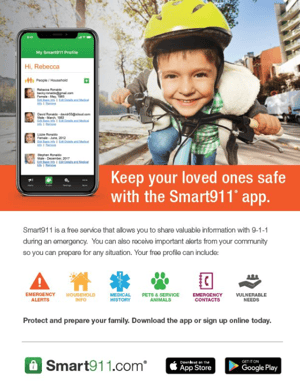 We’re all taught about 9-1-1 at a young age. When you call 9-1-1 the main things to keep in mind are:
We’re all taught about 9-1-1 at a young age. When you call 9-1-1 the main things to keep in mind are:
- You need to give your location.
- You should always stay on the line.
- When calling 911, always answer their questions.
But what happens if you’re in a situation where you can’t speak? Hiding from an attacker, or physically incapacitated? What if it’s a child that calls 9-1-1 and is unable to answer their questions? What if you’re on the beach or in a park and don’t know the nearest physical address to your location? What if you accidentally state the address wrong, or multiple people call 911 and provide different sets of location information?
With all the technology we have today, people think it’s easy for 9-1-1 dispatchers to locate you – they can just ping your cell phone, right? WRONG. Over 80% of calls made to 9-1-1 come from mobile phones. When you dial 9-1-1 from a mobile phone, the 9-1-1 call takers have very little information to help you – only your phone number and a very general idea of where you’re located. Sometimes the nearest cell phone tower can even place your call to a different, neighboring county.
But how can food delivery services and apps like Uber and Lyft find my location, you may ask? Those apps use location sharing. You give them direct access to your GPS when you download the app and allow location sharing so that they can pinpoint your exact location via Wifi and Internet. That technology is not accessible for 9-1-1 call centers, and because of lawmakers and cellphone carriers, it’s not something that can be easily changed or created.
At the end of the day, the more clear-cut, accurate information you can give a 9-1-1 dispatcher, the easier and quicker they’ll be able to find you and send help – and in an emergency, every second counts.
You can be prepared for any emergency situation with a Smart911 account.
What is Smart911?
Smart911 is a free service, available to anyone, that allows you to set up a private and secure Safety Profile that will provide additional details that 9-1-1 call takers may need in order to assist them in locating and helping you during an emergency. When you set up your Safety Profile you can include ample information on:
- Address and location details (including things like visual details, hidden driveways or gate codes)
- People living in your household
- Pets, service animals and livestock
- Medications and medical equipment
- Vehicle descriptions
- Phone numbers associated with your family
- Medical conditions and allergies
- Property details, layout of house and utility information
- Emergency contacts
- Any other special notes you would want first responders to know
Providing detailed information like this will help facilitate a much faster response from first responders in an emergency situation. No matter where you or your loved ones are, you can always have peace of mind that responders will know any critical information and how to help before they even arrive.
Smart911 Safety Profile can also provide your family's photos and descriptions before an emergency, for example, if your child is missing. When you call 9-1-1, your Smart911 Safety Profile displays on the 9-1-1 screen and the 9-1-1 call takers can view any and all information you have added to your profile – including photos and descriptions of your children – that they will be able to disperse to the proper authorities at that time. Smart911 is also a national service, so your Smart911 Safety Profile travels with you and will be visible to any participating 9-1-1 center nationwide.
You can create your Smart911 Safety Profile here. Take the 5 minutes to create a profile, because that 5 minutes could save you or your loved ones life.
Also, check out Rave Facility – which is a Smart911 Safety Profile but for Businesses, Schools and other buildings. With Rave Facility, you can take an active role in protecting your employees, students, guests, and property by providing any information about your facilities that you want 9-1-1 and first responders to know, ahead of any emergency.


